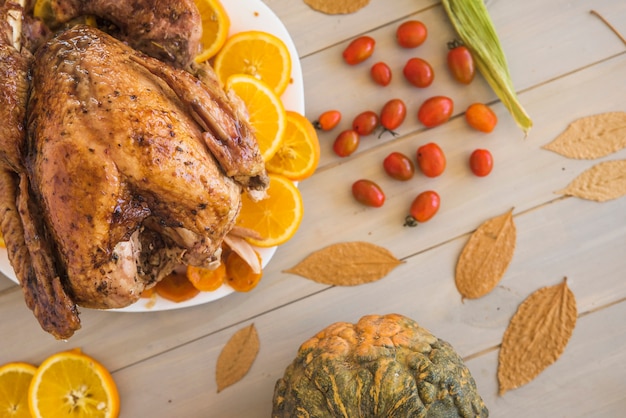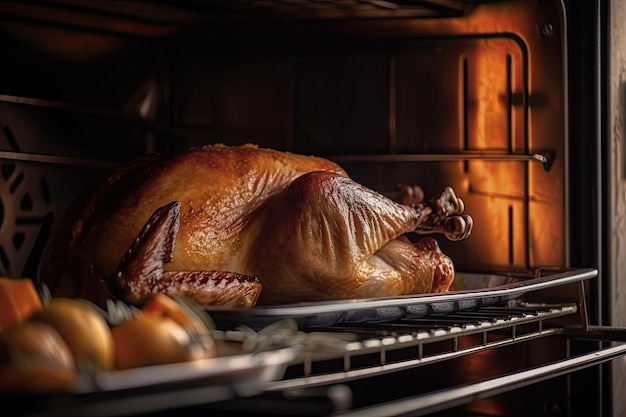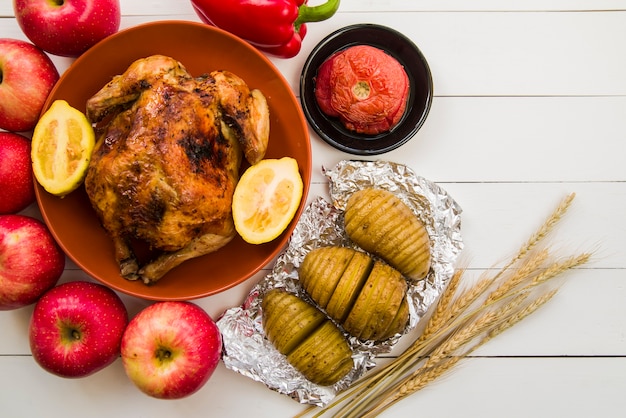The aroma of a perfectly roasted turkey is enough to make anyone's mouth water. It's the centerpiece of countless holiday feasts, a symbol of celebration and togetherness. But mastering the art of turkey roasting can be daunting, especially with a hefty 12lb bird. Fear not, my fellow cooks, because I'm here to guide you through the process, sharing my years of experience and tips for achieving a succulent, golden-brown, and perfectly cooked turkey that'll leave your guests wanting more.
(Part 1) The Turkey Prep: Setting the Stage for Success

You wouldn't start building a house without a solid foundation, and the same goes for a perfect roast turkey. The initial prep work is crucial for ensuring even cooking and maximizing flavor. So, let's roll up our sleeves and get this bird ready for its star turn!
1. The Turkey's First Bath: Washing and Drying
Before we even think about seasoning, the turkey needs a thorough wash. I always run cold water inside and out, making sure to rinse away any excess packaging or debris. Then, it's time for a good pat-down. Using paper towels, dry the turkey thoroughly, getting into every crevice to ensure a crisp skin later on.
2. Seasoning: A Symphony of Flavors
Now comes the fun part: flavoring our feathered friend. My go-to recipe is a simple yet effective blend of olive oil, salt, pepper, and herbs. The olive oil helps create that gorgeous golden-brown crust, while the salt and pepper add depth, and the herbs? Well, they create a beautiful symphony of aromas that fills the kitchen with a tantalizing fragrance.
But let's talk specifics. For herbs, I love a classic mix of rosemary, thyme, and sage. These aromatic herbs complement the turkey perfectly, adding a touch of warmth and complexity. Feel free to experiment with other combinations based on your preferences. Some people like to add a touch of garlic powder, paprika, or even a hint of citrus zest to their seasoning blend. The possibilities are endless!
3. The Stuffing Dilemma: To Stuff or Not to Stuff?
Ah, stuffing. The subject of endless debate among cooks. Some swear by stuffing the turkey, while others advocate against it. My personal preference? I'm a big fan of a traditional sausage and breadcrumb stuffing, packed with herbs and aromatics. It's a delicious addition that adds another layer of flavor to the meal.
However, if you choose to stuff your turkey, I strongly recommend doing it the day before. This allows the stuffing to chill thoroughly in the fridge, preventing any potential bacterial growth and ensuring even cooking. It's also a good idea to stuff the turkey loosely to allow steam to escape during cooking.
4. The Big Reveal: Placing the Turkey in the Oven
With your seasoned and stuffed (or not) turkey ready, it's time to reveal the star of the show: the oven. Make sure your oven is preheated to 350°F (175°C), giving it time to reach its optimal temperature.
When placing the turkey in the oven, ensure there's ample space around it for hot air to circulate. This will ensure even cooking and prevent the turkey from getting stuck to the bottom of the roasting pan.
And here's a little trick my mum taught me: placing a roasting tin filled with water on the bottom rack of the oven creates steam, which helps keep the turkey moist. This is especially useful for larger turkeys, as they can tend to dry out more easily.
(Part 2) The cooking time: Navigating the Time Maze

We've prepped our turkey, the oven is roaring, and we're ready to begin the roasting process. But how long do we cook a 12lb turkey? This is where the real art comes in.
1. The Rule of Thumb: A Starting Point
The general rule of thumb for roasting turkey is 15 minutes per pound at 350°F (175°C). So, for a 12lb turkey, that translates to 180 minutes, or a solid 3 hours of roasting time. But remember, this is just a starting point, a guideline.
2. The internal temperature: The Real Ruler
The true measure of a perfectly cooked turkey lies not in time, but in its internal temperature. The USDA recommends an internal temperature of 165°F (74°C) for the thickest part of the thigh. This ensures the turkey is cooked through and safe to eat.
3. Using a meat thermometer: Your Cooking Companion
Investing in a good meat thermometer is a wise decision for any cook, and it's especially valuable when dealing with a large bird like a turkey. It takes the guesswork out of cooking and guarantees a perfectly cooked turkey every time.
Insert the thermometer into the thickest part of the thigh, making sure not to touch any bone. The thermometer will give you a precise reading of the internal temperature, allowing you to adjust the cooking time as needed.
4. Avoiding Overcooking: The Balancing Act
Overcooking a turkey is a common mistake that can lead to a dry, tough bird. If you're worried about overcooking, you can remove the turkey from the oven when it reaches 160°F (71°C). It will continue to cook for a few minutes after you take it out of the oven, allowing it to reach the desired 165°F (74°C).
5. Resting Time: Letting the Juices Settle
Once your turkey is cooked, resist the temptation to carve it immediately. Give it a chance to rest for at least 30 minutes before carving. This allows the juices to redistribute evenly throughout the meat, resulting in a much juicier and more flavorful turkey. Cover the turkey with foil to keep it warm while it rests.
(Part 3) Basting: The Magic Touch for Flavor and Moisture

Basting is a key step in achieving a perfectly roasted turkey. It not only keeps the bird moist but also adds an extra layer of flavor, ensuring a delicious and satisfying meal.
1. The Art of Basting: A Simple Process
Basting is incredibly simple. Just use a spoon to spoon the turkey drippings over the bird every 30 minutes or so. The drippings are naturally flavorful and add a touch of richness to the turkey.
2. Enhancing the Flavor: Using Butter and Stock
For an extra burst of flavor, you can mix the turkey drippings with some butter or stock. The butter adds a creamy richness, while the stock contributes a savory depth to the basting liquid. Experiment with different types of stock, like chicken, beef, or even vegetable broth, to add a unique flavor profile to your turkey.
3. When to Baste: The Timing is Everything
Start basting your turkey about halfway through the cooking time. Keep an eye on the drippings and make sure they're not burning. If they start to look a bit too brown, add a bit of water to the roasting pan to prevent burning.
(Part 4) Signs of a Perfectly Cooked Turkey: Knowing When It's Ready
With all the roasting, basting, and temperature checks, it can be a little overwhelming to know when the turkey is truly ready. But fear not, there are telltale signs to guide you!
1. The Golden-Brown Crust: A Visual Indicator
One of the most obvious indicators of a perfectly cooked turkey is the golden-brown crust. The skin should be crisp and nicely browned, indicating that the turkey has been cooked through properly.
2. The Thermometer Test: The Ultimate Confirmation
The most reliable way to check if your turkey is cooked through is by using a meat thermometer. Insert it into the thickest part of the thigh, making sure it doesn't touch any bone. If the temperature reads 165°F (74°C), your turkey is ready for carving.
3. The Leg Test: A Traditional Method
My grandma taught me this little trick: if you wiggle the turkey leg, it should move easily and feel loose. If it feels tight, it needs a little more cooking time. It's a classic method that can give you a good indication of doneness.
(Part 5) Tackling a Large Bird: Roasting a 12lb Turkey
Roasting a 12lb turkey is a bit like cooking for an army, but don't worry, with the right techniques, you can achieve a perfectly cooked bird, even with its generous size.
1. Oven Space: Ensuring Even Cooking
A 12lb turkey is a big bird, and it needs to cook evenly. This is why having enough space around it in the oven is crucial. I usually use a large roasting pan, ensuring there's sufficient room for heat to circulate.
2. Avoiding Overcrowding: Maximizing Airflow
If your pan is too crowded, the turkey won't cook evenly, and the skin might not get crispy. If you're concerned about space, you can always roast the turkey in two separate parts, like the breast and the legs, and put them together for the final part of the cooking time.
3. The Importance of a Roasting Rack: Elevating the Turkey
I always use a roasting rack to help with airflow around the turkey. This prevents the bottom of the turkey from getting soggy and ensures the skin cooks evenly. It's a simple yet effective trick that enhances the overall roasting process.
(Part 6) Tips for a perfect turkey: Fine-Tuning Your Roast
We've covered the basics, but here are a few extra tips to ensure your turkey is truly exceptional:
1. Beyond the Bird: Delicious Sides
A perfect roast turkey isn't just about the bird itself; it's about the entire meal. Don't forget those delicious sides that complement the turkey beautifully. My go-to sides are roast potatoes, gravy, stuffing, and vegetables like carrots, parsnips, and Brussels sprouts.
2. Gravy: The Perfect Finishing Touch
The gravy is a key part of any turkey dinner. I use the turkey drippings to make my gravy, and I always add a splash of red wine for extra flavor. Experiment with different herbs and spices to create your signature gravy.
3. Planning is Everything: A Stress-Free Feast
Don't leave everything to the last minute. Plan your menu in advance and ensure you have all the ingredients you need. It's a good idea to prepare some of the sides ahead of time, such as the stuffing or the vegetables. This will make your cooking day a breeze.
(Part 7) turkey leftovers: A Culinary Treasure Trove
Once you've devoured your turkey dinner, you'll likely have some leftovers. Don't throw them away! Leftover turkey is a culinary treasure trove, ready for a whole new adventure in the kitchen.
1. Leftover Magic: Turning Leftovers into Delights
There are endless possibilities when it comes to leftover turkey. You can create delicious sandwiches, soups, salads, or even pies. Get creative and let your culinary imagination run wild!
2. Classic turkey sandwiches: A Simple Feast
One of the easiest and most satisfying ways to use leftover turkey is to make sandwiches. Add some cranberry sauce, stuffing, and mayonnaise for a delicious and satisfying lunch.
3. turkey soup: A Warm and Comforting Meal
For a comforting meal, try making a hearty turkey soup. Add some vegetables, noodles, and a splash of broth. It's a perfect way to warm up on a chilly day.
4. Turkey Shepherd's Pie: A Hearty and Savory Option
For a more substantial meal, try making a turkey shepherd's pie. Use the leftover turkey meat in a creamy sauce and top it with mashed potatoes.
5. turkey salad: A Light and Refreshing Choice
For a lighter option, try making a turkey salad. Combine chopped turkey, celery, mayonnaise, and your favorite seasonings. It's a great option for a lunch or light dinner.
(Part 8) FAQs: Addressing Your Turkey Questions
Here are some common questions that pop up when tackling a 12lb turkey:
1. Turkey Too Big for the Oven? A Simple Solution
If your turkey is too big for your oven, you can roast it in two parts. Roast the breast and legs separately, then assemble them for the final part of the cooking time. Just make sure the turkey is cooked thoroughly before serving.
2. Can I Freeze a Cooked Turkey?
Yes, you can freeze your cooked turkey for up to 2 months. Make sure you wrap it tightly in plastic wrap and aluminum foil before putting it in the freezer. This will help prevent freezer burn and maintain its freshness.
3. What if My Turkey is Undercooked?
If you're unsure if your turkey is cooked through, you can always cook it a little longer. Just check the internal temperature with a meat thermometer to make sure it reaches 165°F (74°C).
4. How to Carve a Turkey: A Skillful Guide
Start by removing the legs and thighs. Then, carve the breast meat into slices. Be careful not to cut into the bones. If you're not confident in your carving skills, there are plenty of online tutorials that can guide you through the process.
5. Extra Tips for Turkey Roasting: Mastering the Art
Here are a few more tips to help you achieve that perfect roast turkey:
- Don't overstuff the turkey. This can make it difficult to cook evenly.
- Don't baste too often. This can prevent the skin from getting crispy.
- Don't overcook the turkey. It will become dry and tough.
(Part 9) The Perfect Roast Turkey: A Culinary Triumph
And there you have it, my fellow cooks! My tried-and-tested method for a perfect roast turkey. It may seem like a lot of steps, but trust me, it's worth every bit of effort. When you see that golden-brown bird, smell the delicious aroma, and taste that juicy meat, you'll know all your hard work was worth it.
A perfect roast turkey is more than just a meal; it's a symbol of warmth, family, and celebration. It's a reminder of all the things we hold dear and a testament to the joy of sharing a good meal with loved ones. So, go forth and cook your turkey with confidence, knowing you have all the tools and tips you need to create a truly memorable feast.
Everyone is watching

Corn on the Cob: The Ultimate Guide to Perfectly Cooked Ears
Healthy MealsAh, corn on the cob. Just the name evokes images of sunny days, barbecues, and that sweet, juicy flavour that ...

Perfect Pork Roast Oven Cooking Time: A Guide to Delicious Results
Healthy MealsThere's something truly satisfying about a perfectly roasted pork. The aroma alone is enough to make your mout...

Ham Cooking Time: How Long to Bake, Smoke, or Boil a Delicious Ham
Healthy MealsAh, ham. It's a classic, isn't it? A real crowd-pleaser, especially around holidays. And when done right, it'...

Scallops: The Ultimate Guide to Perfect Cooking
Healthy MealsAh, scallops. Those delicate, sweet, and utterly delicious morsels of the sea. They hold a special place in my...

Spaghetti Squash: The Ultimate Guide to Cooking and Serving
Healthy MealsRemember that time you saw spaghetti squash at the supermarket, looking all bumpy and strange, and thought, "W...
